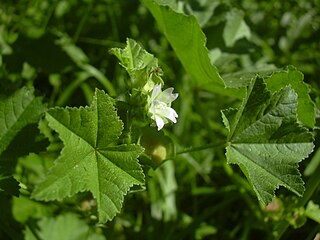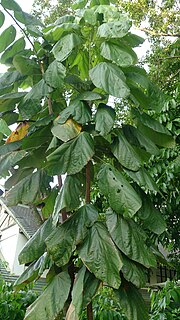
Sorghum is a genus of flowering plants in the grass family Poaceae. Seventeen of the 25 species are native to Australia, with the range of some extending to Africa, Asia, Mesoamerica, and certain islands in the Indian and Pacific Oceans. One species is grown for grain, while many others are used as fodder plants, either cultivated in warm climates worldwide or naturalized, in pasture lands. Sorghum is in the subfamily Panicoideae and the tribe Andropogoneae.

A bicolor cat or piebald cat is a cat with white fur combined with fur of some other color, for example black or tabby. There are various patterns of bicolor cat. These range from Turkish Van pattern through to solid color with a throat locket.

Malvaceae, or the mallows, is a family of flowering plants estimated to contain 244 genera with 4225 known species. Well-known members of economic importance include okra, cotton, cacao and durian. There are also some genera containing familiar ornamentals, such as Alcea (hollyhock), Malva (mallow) and Lavatera, as well as Tilia. The largest genera in terms of number of species include Hibiscus, Sterculia, Dombeya, Pavonia and Sida.

Sorghum bicolor, commonly called sorghum and also known as great millet, durra, jowari, or milo, is a grass species cultivated for its grain, which is used for food for humans, animal feed, and ethanol production. Sorghum originated in Africa, and is now cultivated widely in tropical and subtropical regions. Sorghum is the world's fifth-most important cereal crop after rice, wheat, maize, and barley. S. bicolor is typically an annual, but some cultivars are perennial. It grows in clumps that may reach over 4 m high. The grain is small, ranging from 2 to 4 mm in diameter. Sweet sorghums are sorghum cultivars that are primarily grown for forage, syrup production, and ethanol; they are taller than those grown for grain.

The bicolored roundleaf bat is a species of bat in the family Hipposideridae found in Indonesia, Malaysia, the Philippines, Thailand, and Timor-Leste. This bat inhabits caves, rock crevices and tunnels among lowland forests. They roost in large numbers and consumer mostly small winged insects. Their navigation and hunting skills come from the use of echolocation. Its leafnose is used to release ultrasonic shouts to distinguish its surroundings. Echolocation is also used to distinguish other species based on their wingbeat and size. The habitat of this bat decides the color of its fur. Bleaching fumes of a cave environment will cause an orange colored fur. Those who inhabit a well-ventilated roost will be a light brown color.

Theobroma bicolor, known commonly as the Mocambo tree, jaguar tree, balamte, or pataxte, among various other common names, is a tree in the genus Theobroma, which also contains the better-known Theobroma cacao. It is known from Central and South America, including stretches of the Amazon rainforest in Brazil, Colombia, Ecuador, and Peru.
Astathini is a tribe of longhorn beetles of the Lamiinae subfamily. It was described by Thomson in 1864.
Bacchisa is a genus of longhorn beetles of the subfamily Lamiinae.
Bacchisa melanura is a species of beetle in the family Cerambycidae. It was described by Pascoe in 1867. It is known from Malaysia and Singapore.
Bacchisa aulica is a species of beetle in the family Cerambycidae. It was described by Pascoe in 1867. It is known from Sulawesi.
Bacchisa papuana is a species of beetle in the family Cerambycidae. It was described by Breuning in 1956.
Bacchisa sumatrensis is a species of beetle in the family Cerambycidae. It was described by Breuning in 1950. It is known from Sumatra.
Bacchisa pallidiventris is a species of beetle in the family Cerambycidae. It was described by Thomson in 1865. It is known from China, Laos and Vietnam.
Bacchisa nigriventris is a species of beetle in the family Cerambycidae. It was described by Thomson in 1865. It is known from Borneo and Malaysia.
Bacchisa kraatzii is a species of beetle in the family Cerambycidae. It was described by Thomson in 1865. It is known from Java and the Philippines.
Bacchisa atritarsis is a species of beetle in the family Cerambycidae. It was described by Pic in 1912. It is known from China.
Bacchisa guerryi is a species of beetle in the family Cerambycidae. It was described by Pic in 1911. It is known from Laos and China. It contains the varietas Bacchisa guerryi var. apicalis.
Bacchisa coronata is a species of beetle in the family Cerambycidae. It was described by Pascoe in 1866.
Bacchisa dioica is a species of beetle in the family Cerambycidae. It was described by Fairmaire in 1878. It is known from China.
Bacchisa fortunei is a species of beetle in the family Cerambycidae. It was described by Thomson in 1857. It is known from Japan.







